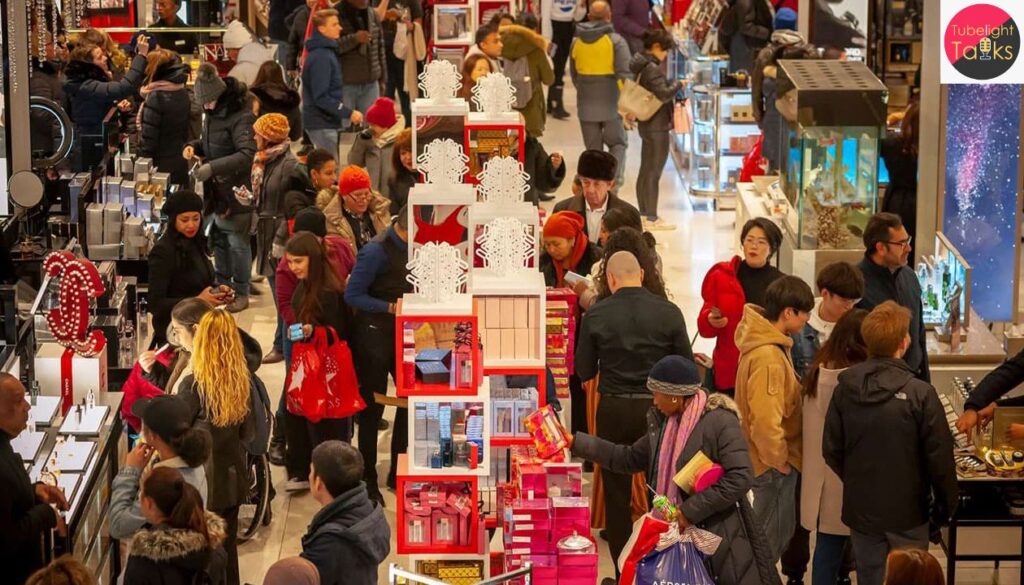Black Friday 2025: The upcoming holiday shopping season in the United States is shaping up very differently than traditional years. Historically, the marquee day known as Black Friday—the Friday following Thanksgiving—served as the unofficial launch of the holiday shopping period. But for 2025, retailers are extending that window, launching deals in October, and expecting momentum into early December.
What’s New This Year
Early Promotions & Extended Season
Multiple reports indicate that retailers are beginning their Black Friday‑style promotions well ahead of the typical late‐November date. According to industry analysis, the “deal window” is lengthening as retailers try to ease shipping/logistics pressure and capture consumers earlier. This “holiday creep” is not new, but it is more pronounced in 2025.
Mobile Commerce Takes Center Stage
Online and mobile shopping continues to dominate. Analysts estimate that mobile devices could account for over 70% of online purchases during the Black Friday period. Retailers are investing in mobile checkout, app‑exclusive deals and seamless digital experiences.
Consumer Behaviour & Discount Fatigue
A key risk for retailers this year is that many consumers report they are less excited about massive sale events compared to previous years. One survey shows around 30% fewer shoppers prioritise mega‑sale weekends. With inflation and cost pressures, customers are being more selective rather than simply waiting for the biggest discount.

Forecasts & Key Metrics for 2025
Online Spending and Growth Expectations
For the U.S., online Black Friday sales in 2025 are projected to be around US$10.8 billion to US$11.9 billion according to some estimates — showing modest growth (0‑10%) compared with 2024. At the same time, overall holiday‑retail growth is expected to be in the 2.7‑3.7% range according to the National Retail Federation.
Discount Levels
One report finds that the average discount depth for 2025 may hover around 28%, slightly weaker than last year’s best offers. Retailers may offer fewer “extraordinary loss‑leader” deals in favour of sustained, targeted promotions.
Category Winners & Trends
Electronics, apparel, home goods remain key drivers, but newer categories like health‑tech, smart home, and sustainability‑oriented products are gaining traction. Extended‑window promotions allow more time for consumer decision‑making rather than rush purchases.
Retailer Strategy & Operational Challenges
Inventory & Logistics Readiness
With the promotional period lengthening, retailers face pressure on inventory planning, fulfilment, and shipping. Early deals help spread out load, but supply‑chain disruptions remain a concern.
Omnichannel Experience
Stores and online channels must coordinate — some deals will be app‑only or in‑store exclusive. Mobile‑first checkout, click‑and‑collect, and flexible returns are differentiators.

Smaller Retailers & Niche Brands
Smaller players cannot match deep discounts by big‑boxes, but they can win via niche focus, community engagement and loyalty deals. The elongated season gives them a chance to engage earlier.
Risks & Watch‑Points for 2025
Consumer Budget Constraints
Despite the hype, consumers face inflation, rising living costs and wage pressures. This may reduce discretionary spending and raise the risk of weaker growth in unit volume, even if revenue rises nominally.
Discount Erosion & Margin Pressure
If discounts are shallower but sustained, retailers may struggle with margin compression, especially if cost inflation (shipping, labour, supplies) remains elevated.
Event Saturation & Lower Urgency
With deals starting earlier and running longer, the “big moment” effect may fade. Consumers might delay purchases, degrade urgency, and fragment spending across the season.
Returns & Customer Experience
Extended promotion windows often lead to higher return rates. Retailers need strong return‑logistics and customer support to avoid negative post‑holiday impact. One study showed high cart abandonment when shipping or returns were sub‑optimal.
Also Read: The Real Cost of ‘Buy Now, Pay Later’ Schemes
Align with Purpose
In an era of blitz‑deals, promotional urgency and consumer chasing, the teachings of Sant Rampal Ji Maharaj invite a deeper reflection: True value does not lie simply in the “buy more, faster” mindset, but in mindful consumption, ethical spending and the equitable benefit of goods and services. As retailers rush to stretch the shopping window and consumers weigh every discount, this season becomes not just about what we purchase—but why we purchase. Real holiday spirit may be found not in the size of the savings, but in how our spending aligns with purpose, sustainability and shared well‑being.
What to Monitor as the Season Unfolds
Deal Start Dates & Event Timing
Keep an eye on how many retailers open promotions in October vs. the traditional Black Friday weekend.
Mobile & App Engagement Metrics
Look for data on mobile share, checkout speed, conversion from mobile vs desktop, and use of loyalty‑app promotions.
Promotional Depth & Duration
Track how many “door‑buster” items still exist vs. sustained deals, and whether discounts are front‑loaded or spread.
Consumer Sentiment & Spending Intent
Survey data about how many consumers plan to take part, what segments (Gen Z, Millennials) are driving volume and how budget‐sensitive households behave.
Returns & Post‑Holiday Impact
Retailers’ Q1 2026 reports may reflect how many early sales converted successfully vs. returned items and post‑season loss.
FAQs: Black Friday 2025 Holiday Shopping Season
Q1. When does Black Friday 2025 officially start?
Traditionally the Friday after Thanksgiving in the U.S., but in 2025 many retailers are launching deals as early as October and running through early December.
Q2. How much online spending is expected in 2025?
Estimates suggest U.S. online Black Friday sales may reach between US$10.8 billion to US$11.9 billion in 2025, representing moderate growth.
Q3. Are discounts expected to be as steep as past years?
Not necessarily. Average discount levels are expected to hover around 28%, slightly weaker than previous years due to economic pressures.
Q4. What role will mobile shopping play?
Mobile commerce is critical — projections indicate over 70% of online holiday shopping may originate from mobile devices.
Q5. Can smaller retailers compete in the extended season?
Yes—though they may not match deep discounts from big‑boxes, smaller retailers can compete with niche focus, early engagement, loyalty incentives and superior customer experience.










